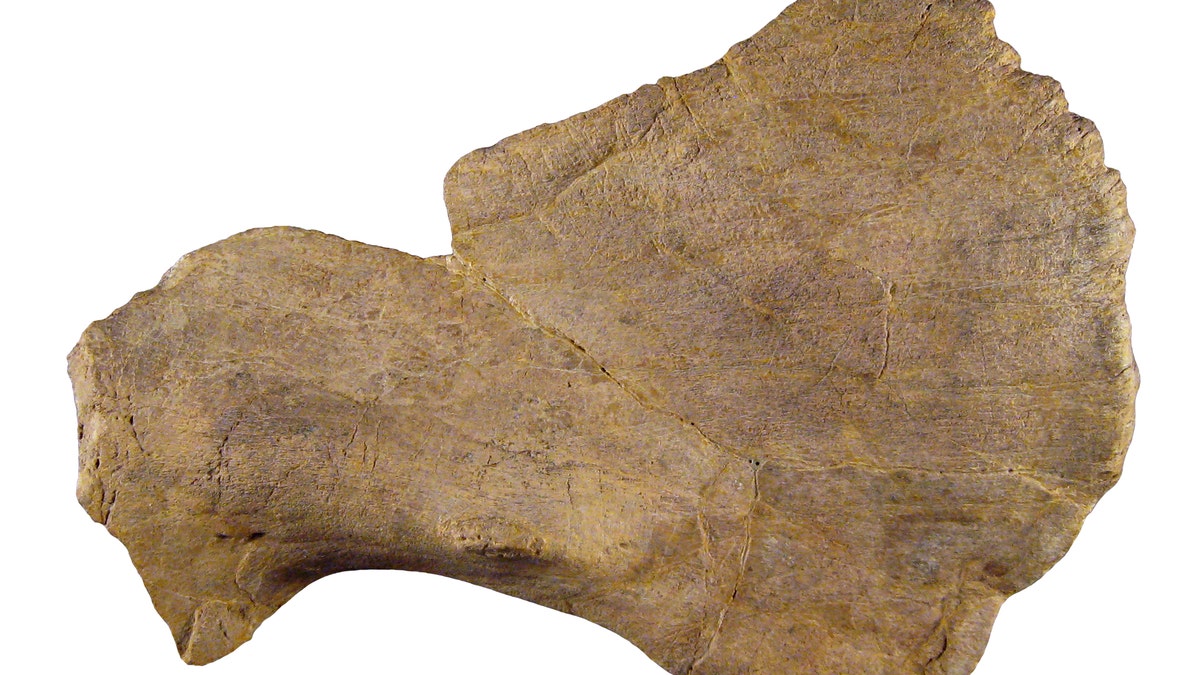
A restoration of the Crittendenceratops krzyzanowskii. (Sergey Krasovskiy)
A team of paleontologists recently announced the discovery of a new horned dinosaur — a "cousin" of the Triceratops — in southern Arizona.
The new species, Crittendenceratops krzyzanowskii, was named after the rock formation the fossils were buried under (Fort Crittenden Formation) as well as the late amateur scientist Stan Krzyzanowski, who first found the fossils.
The bones of the dinosaur were uncovered underneath 73-million-year-old rocks about 20 years ago southeast of Tucson, but a team from the New Mexico Museum of Natural History and Science (NMMNH) recently studied the specimen and determined it was a new species. Their findings were published in NMMNH's bulletin.
STRANGE CARVED STONE FOUND 'BURIED' UNDER NEW JERSEY RIVER PUZZLES LOCALS
"I told my boss and co-author Spencer Lucas that this is a new species and that I am going to work on it. I am a taxonomist and morphologist, so I was able to find numerous morphological features right away in the material of Crittendenceratops to establish a new species," Sebastian Dalman, lead researcher on the project, told Newsweek on Monday. "Later with the help of my good friend and co-author of other projects Jonathan Wagner, a new phylogenetic analysis was conducted that shows the relationships of Crittendenceratops to other ceratopsians."
The dinosaur was likely 11 feet long and weighed around 1,500 pounds, researchers said. The Phoenix New Times compared the size of the creature to an elephant, explaining it's part of the Ceratopsidae family.

Crittendenceratops' squamosal bone. (New Mexico Museum of Natural History and Science)
"The significance of this discovery is that Crittendenceratops represents the youngest member of Nasutoceratopsini and that this group was still living in North America near the end of the Cretaceous," Dalman said. "It coexisted with two other groups of horned dinosaurs (ceratopsians): centrosaurs and chasmosaurs. It also shows that ceratopsian dinosaurs were highly diverse both morphological and taxonomical."
Spencer Lucas, a curator at NMMNH and co-author of the paper, said it was a significant find in the state.
SCIENTISTS FIND 3 BIZARRE NEW SEA CREATURE IN PITCH-BLACK PART OF PACIFIC OCEAN
"I can’t even think of six dinosaurs that have been named from Arizona," he told the Phoenix New Times, noting that the area the dinosaur once walked was "a greenhouse world."
During the Late Cretacious period, there was a large lake present in the area where the Crittendenceratops roamed. The greenery was convenient for the dinosaur, as it was a plant eater — just like its relatives.
"[It] probably ate anything it could get into its mouth," Lucas joked.
The classification of the dinosaur has given Arizona researchers a push to continue studying other specimens that have previously been recovered in the state.
"Between the mid 1990’s and 2000, a number of new ceratopsian specimens were collected by teams at the Arizona- Sonora Desert Museum (ASDM) and the New Mexico Museum of Natural History and Science (NMMNH) from the upper Campanian Fort Crittenden Formation of Adobe Canyon within the Santa Rita Mountains of southeastern Arizona (Figs. 1-2). These new specimens provide important new information about the morphologic and taxonomic diversity of Ceratopsidae in North America," the researchers wrote.
Lucas said it's proof paleontologists have a "lot more field work" ahead of them.
"There are a lot more dinosaurs out there in Arizona to be discovered," Lucas told the Phoenix New Times. "Young people need to know — you can probably go out and find a new dinosaur in Arizona."
